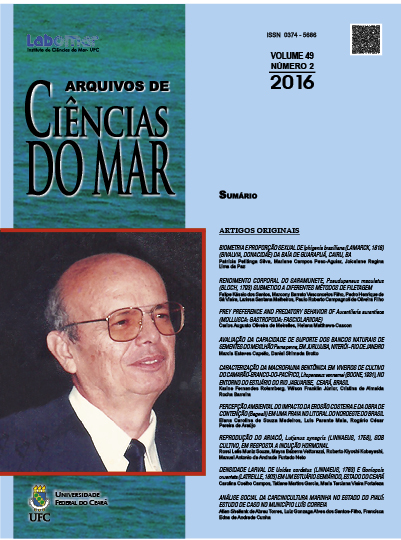Spawning of farmed lane snapper, Lutjanus synagris (Linnaeus, 1758), in response to hormonal induction
DOI:
https://doi.org/10.32360/acmar.v49i2.6582Keywords:
Lutjanus synagris, spawning, hormonal induction, hCG, fish farming.Abstract
The aim of this study was to perform the hormonal induced spawning of the lane snapper, Lutjanus synagris, using human Chorionic Gonadotropin (hCG) as hormonal treatment. There was made use of 72 specimens, being 24 females and 48 males, with average weights of 0.381±0.154 kg and 0.353±0.105 kg, respectively, in three treatments with eight replicates. Females in Treatment 1 (T1) received a total dose of 1.000 IU hCG/Kg of body weight, and those in T2 and T3 received a total dose of 1.250 and 1.500 UI hCG/Kg of body weight, respectively. Spawnings occurred between eight and twelve hours after the hormonal treatment, and the fertilized eggs presented spherical shape, transparency, narrow perivitelline space, clear chorion, homogeneous and non-segmented yolk, visible oil drop as well as no pigmentation and buoyant features. The average non-fertilized egg, fertilized egg and oil drop diameters values were T1: 425±16, 659±10 e 139±2 µm; T2: 427±15, 661±14 e 140±5 µm; T3 422±10, 667±20 e 141±5 µm, respectively. The number of released oocytes varied from a minimum value of 405.797±230.812 eggs (T2) to a maximum value of 556.661±209.171 eggs (T!). The highest fertilization rate was observed in T1 with 75±10%, followed by T2 and T3 with 66±7% and 65±17%, respectively.Downloads
Downloads
Published
2017-05-05
How to Cite
Souza, R. L. M., Vettorazzi, M. B., Kobayashi, R. K., & Neto, M. A. de A. F. (2017). Spawning of farmed lane snapper, Lutjanus synagris (Linnaeus, 1758), in response to hormonal induction. Arquivos De Ciências Do Mar, 49(2), 68–76. https://doi.org/10.32360/acmar.v49i2.6582
Issue
Section
Artigos originais
License
1. Proposta de Política para Periódicos de Acesso Livre
Autores que publicam nesta revista concordam com os seguintes termos:
- Autores mantém os direitos autorais e concedem à revista o direito de primeira publicação, com o trabalho simultaneamente licenciado sob a Licença Creative Commons Attribution que permite o compartilhamento do trabalho com reconhecimento da autoria e publicação inicial nesta revista.
- Autores têm autorização para assumir contratos adicionais separadamente, para distribuição não-exclusiva da versão do trabalho publicada nesta revista (ex.: publicar em repositório institucional ou como capítulo de livro), com reconhecimento de autoria e publicação inicial nesta revista.
- Autores têm permissão e são estimulados a publicar e distribuir seu trabalho online (ex.: em repositórios institucionais ou na sua página pessoal) a qualquer ponto antes ou durante o processo editorial, já que isso pode gerar alterações produtivas, bem como aumentar o impacto e a citação do trabalho publicado (Veja O Efeito do Acesso Livre).

